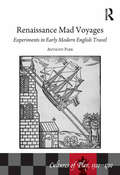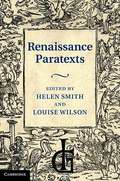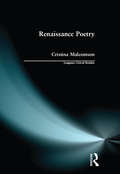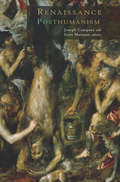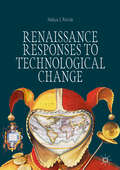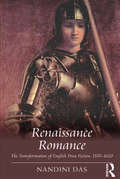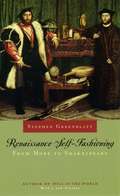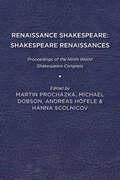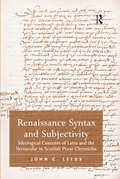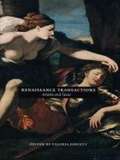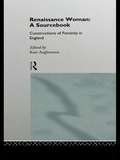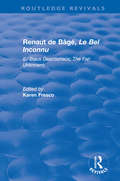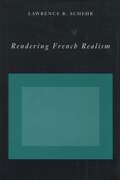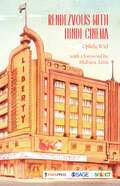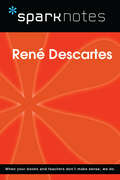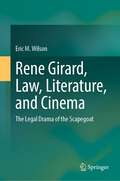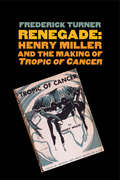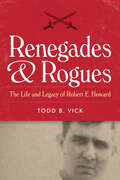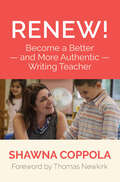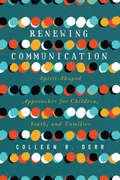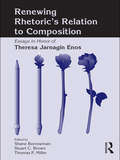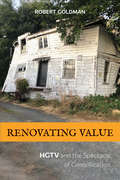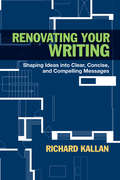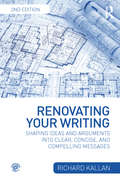- Table View
- List View
Renaissance Mad Voyages: Experiments in Early Modern English Travel (Cultures Of Play, 1300-1700 Ser.)
by Anthony ParrA vogue for travel ’stunts’ flourished in England between 1590 and the 1620s: playful imitations or burlesques of maritime enterprise and overland travel that collectively appear to be a response to particular innovations and developments in English culture. This study is the first full length scholarly work to focus on the curious phenomenon of ’madde voiages’, as the writer William Rowley called them. Anthony Parr shows that the mad voyage (as Rowley and others conceived it) had surprisingly deep and diverse roots in traditional travel practices, in courtly play and mercantile custom, and in literary culture. Looking in detail at several of the best-documented exploits, Parr situates them in the ferment of such ventures during the period in question; but also reaches back to explore their classical and mediaeval antecedents, and considers their role in creating a template for eccentric English adventure in later centuries. Renaissance Mad Voyages brings together literary and historical enquiry in order to address the implications of an interesting and neglected cultural trend. Parr's investigation of the rash of travel exploits in the period leads to extensive research on the origins of the wager on travel and its role in the expansion of English tourism and trading activity.
Renaissance Paratexts
by Louise Wilson Helen SmithIn his 1987 work Paratexts, the theorist Gérard Genette established physical form as crucial to the production of meaning. Here, experts in early modern book history, materiality and rhetorical culture present a series of compelling explorations of the architecture of early modern books. The essays challenge and extend Genette's taxonomy, exploring the paratext as both a material and a conceptual category. Renaissance Paratexts takes a fresh look at neglected sites, from imprints to endings, and from running titles to printers' flowers. Contributors' accounts of the making and circulation of books open up questions of the marking of gender, the politics of translation, geographies of the text and the interplay between reading and seeing. As much a history of misreading as of interpretation, the collection provides novel perspectives on the technologies of reading and exposes the complexity of the playful, proliferating and self-aware paratexts of English Renaissance books.
Renaissance Poetry (Longman Critical Readers)
by Cristina MalcomsonThis book, the first single volume to collate essays about sixteenth and seventeenth century poetry, explores the remarkable changes that have occurred in the interpretation of English Renaissance poetry in the last twenty years. In the introduction Cristina Malcolmson argues that recent critical approaches have transformed traditional accounts of literary history by analysing the role of poetry in nationalism, the changing associations of poetry and class-status, and the rediscovered writings of women. The collection represents many of the critical methodologies which have contributed to these changes: new historicism, cultural materialism, feminism, and an historically informed psychoanalytic criticism. In particular, three diverse readings of Spenser's 'Bower of Bliss' canto illustrate the different approaches of formalist close-reading, new historicist analysis of cultural imperialism and feminist interpretations of the relation of gender and power. The further reading section categorizes recent work according to issues and critical approaches.
Renaissance Posthumanism
by Joseph Campana and Scott MaisanoConnecting Renaissance humanism to the variety of “critical posthumanisms” in twenty-first-century literary and cultural theory, Renaissance Posthumanism reconsiders traditional languages of humanism and the human, not by nostalgically enshrining or triumphantly superseding humanisms past but rather by revisiting and interrogating them. What if today’s “critical posthumanisms,” even as they distance themselves from the iconic representations of the Renaissance, are in fact moving ever closer to ideas in works from the fourteenth to the seventeenth century? What if “the human” is at once embedded and embodied in, evolving with, and de-centered amid a weird tangle of animals, environments, and vital materiality? Seeking those patterns of thought and practice, contributors to this collection focus on moments wherein Renaissance humanism looks retrospectively like an uncanny “contemporary”—and ally—of twenty-first-century critical posthumanism.
Renaissance Responses to Technological Change
by Sheila J. NayarThis book foregrounds the pressures that three transformative technologies in the long sixteenth century—the printing press, gunpowder, and the magnetic compass—placed on long-held literary practices, as well as on cultural and social structures. Sheila J. Nayar disinters the clash between humanist drives and print culture; places the rise of gunpowder warfare beside the equivalent rise in chivalric romance; and illustrates fraught attempts by humanists to hold on to classicist traditions in the face of seismic changes in navigation. Lively and engaging, this study illuminates not only how literature responded to radical technological changes, but also how literature was sometimes forced, through unanticipated destabilizations, to reimagine itself. By tracing the early modern human’s inter-animation with print, powder, and compass, Nayar exposes how these technologies assisted in producing new ways of seeing, knowing, and being in the world.
Renaissance Romance: The Transformation of English Prose Fiction, 1570–1620
by Nandini DasRomance was criticized for its perceived immorality throughout the Renaissance, and even enthusiasts were often forced to acknowledge the shortcomings of its dated narrative conventions. Yet despite that general condemnation, the striking growth in English fiction in the late sixteenth and early seventeenth centuries is marked by writers who persisted in using this much-maligned narrative form. In Renaissance Romance, Nandini Das examines why the fears and expectations surrounding the old genre of romance resonated with successive new generations at this particular historical juncture. Across a range of texts in which romance was adopted by the court, by popular print and by women, Das shows how the process of realignment and transformation through which the new prose fiction took shape was driven by a generational consciousness that was always inherent in romance. In the fiction produced by writers such as Sir Philip Sidney, Robert Greene and Lady Mary Wroth, the transformative interaction of romance with other emergent forms, from the court masque to cartography, was determined by specific configurations of social groups, drawn along the lines of generational difference. What emerged as a result of that interaction radically changed the possibilities of fiction in the period.
Renaissance Self-Fashioning: From More to Shakespeare
by Stephen GreenblattRenaissance Self-Fashioning is a study of sixteenth-century life and literature that spawned a new era of scholarly inquiry. Stephen Greenblatt examines the structure of selfhood as evidenced in major literary figures of the English Renaissance—More, Tyndale, Wyatt, Spenser, Marlowe, and Shakespeare—and finds that in the early modern period new questions surrounding the nature of identity heavily influenced the literature of the era. Now a classic text in literary studies, Renaissance Self-Fashioning continues to be of interest to students of the Renaissance, English literature, and the new historicist tradition, and this new edition includes a preface by the author on the book's creation and influence. "No one who has read [Greenblatt's] accounts of More, Tyndale, Wyatt, and others can fail to be moved, as well as enlightened, by an interpretive mode which is as humane and sympathetic as it is analytical. These portraits are poignantly, subtly, and minutely rendered in a beautifully lucid prose alive in every sentence to the ambivalences and complexities of its subjects."—Harry Berger Jr., University of California, Santa Cruz
Renaissance Shakespeare/Shakespeare Renaissances: Proceedings of the Ninth World Shakespeare Congress
by Stanley Wells Sukanta Chaudhuri Randall Martin Brian Walsh Ros King James J. Marino Graham Holderness Barry Freeman Shaul Bassi Ann Jennalie Cook Emma Depledge Jean-Christophe Mayer Patrick Lonergan Courtney Lehmann Sharon O'Dair Poonam Trivedi Supriya Chaudhuri Darryl Chalk M. A. Katritzky Jill L. Levenson Margaret Shewring Hersh Zeifman Robert Darcy Joel Rodgers Atsuhiko Hirota Kimberly R. West Richard Fotheringham Eleanor Collins Martin Hilský Vlasta Gallerová Karel Kríž Robert Sturua Galz Engler Madalina Nicolaescu Kaori Kobayashi Zeno Ackermann Tina Krontiris Emily Oliver Carla Della Gatta Cristiane Busato Smith Anna Cetera Bi-Qi Beatrice LeiSelected contributions to the Ninth World Shakespeare Congress, which took place in July 2011 in Prague, represent the contemporary state of Shakespeare studies in thirty-eight countries worldwide. Apart from readings of Shakespeare’s plays and poems, more than forty chapters map Renaissance contexts of his art in politics, theater, law, or material culture and discuss numerous cases of the impact of his works in global culture from the Americas to the Far East, including stage productions, book culture, translations, film and television adaptations, festivals, and national heritage. The last section of the book focuses on the afterlife of Shakespeare in the work of the leading British dramatist Tom Stoppard. Published by University of Delaware Press. Distributed worldwide by Rutgers University Press.
Renaissance Syntax and Subjectivity: Ideological Contents of Latin and the Vernacular in Scottish Prose Chronicles
by John C. LeedsThe relationship between Latin and the Scots vernacular in the chronicle literature of 16th-century Scotland provides the topic for this study. John Leeds here shows how the disposition of grammatical subjects, in the radically dissimilar syntactic systems of humanist neo-Latin and Scots, conditions the way in which "the subject" (i.e., the human individual) and its actions are conceived in the writing of history. In doing so, he extends the boundaries of existing critical literature on early modern "subjectivity" to include the subject of grammar, analyzing its incorporation into narrative sentences and illuminating the ideological contents of different systems for its deployment. Though focused on the chronicles of Renaissance Scotland, the argument can in principle be applied to the entire range of Latin-vernacular relations during the early modern period. While examining the intellectual culture of early modernity, Leeds also takes aim, at every stage of his argument, at the semiotic and social-constructionist orthodoxies that dominate the humanities today. Against the notion that human subjects are "discursive constructs," he argues for the subordination of discourse to realities, both material and immaterial, that are external to language. As part of this argument, he proposes a view of neo-Latin humanism as a resistance to the onset of modernity, arguing that Latin prose provides options (at once syntactic, ideological, and ontological) that vernacular culture has, to its considerable detriment, foreclosed. In sum, Leeds advocates a renewed and theoretically-informed commitment to the humanism that the humanities themselves have been at such pains, during the last scholarly generation, to depreciate.
Renaissance Transactions: Ariosto and Tasso
by Valeria FinucciThe controversy generated in Italy by the writings of Ludovico Ariosto and Torquato Tasso during the sixteenth century was the first historically important debate on what constitutes modern literature. Applying current critical theories and tools, the essays in Renaissance Transactions reexamine these two provocative poet-thinkers, the debate they inspired, and the reasons why that debate remains relevant today. Resituating these writers' works in the context of the Renaissance while also offering appraisals of their uncanny "postmodernity," the contributors to this volume focus primarily on Ariosto's Orlando furioso and Tasso's Gerusalemme liberata. Essays center on questions of national and religious identity, performative representation, and the theatricality of literature. They also address subjects regarding genre and gender, social and legal anthropology, and reactionary versus revolutionary writing. Finally, they advance the historically significant debate about what constitutes modern literature by revisiting with new perspective questions first asked centuries ago: Did Ariosto invent a truly national, and uniquely Italian, literary genre--the chivalric romance? Or did Tasso alone, by equaling the epic standards of Homer and Virgil, make it possible for a literature written in Italian to attain the status of its classical Greek and Latin antecedents? Arguing that Ariosto and Tasso are still central to the debate on what constitutes modern narrative, this collection will be invaluable to scholars of Italian literature, literary history, critical theory, and the Renaissance.Contributors. Jo Ann Cavallo, Valeria Finucci, Katherine Hoffman, Daniel Javitch, Constance Jordan, Ronald L. Martinez, Eric Nicholson, Walter Stephens, Naomi Yavneh, Sergio Zatti
Renaissance Woman: Constructions of Femininity in England
by Kate AughtersonRenaissance Woman: A Sourcebook is an invaluable collection of accounts of women and femininity in early modern England. The volume is divided thematically into nine sections, each with an accessible introduction, notes on sources and an annotated bibliography. The sections are:* Theology * Biology * Conduct * Sexuality and Motherhood * Politics and Law * Education * Work * Writing and Speaking * Feminism Renaissance Woman: A Sourcebook brings together sources ranging from medical documents and political pamphlets to sermons and the Bible, as well as literary sources. Providing a historical context to issues of gender in the Renasissance, it will be essential reading for students of the period, gender studies and cultural history.
Renaut de Bâgé, 'Le Bel Inconnu': ('Li Biaus Descouneüs'; 'The Fair Unknown') (Routledge Revivals)
by Karen FrescoOriginally published in 1992, Le Bel Inconnu edited and with an introduction by Karen Fresco, presents on facing pages the original Old French text and the English translation of this significant medieval romance poem by Renaut de Bâgé The extensive introduction to the text includes an exploration into the life of the author, Renaut de Bâgé, as well as a detailed assessment of the poem, its sources and influences, and the broader genre of medieval romance. It is also equipped with close textual notes, an index of proper nouns, and an examination of Renaut’s Song Leals Amors Q’est Dedanz Fin Cuer Mise, including the musical scores.
Rendering French Realism
by Lawrence R. SchehrRealist novels are usually seen as verisimilar representations of the world, and even when that verisimilitude is critically examined (as it has been by Marxist and feminist critics), the criticism has referred to extra-literary matters, such as bourgeois ideology or defects in the portrayal of women. This book takes as its thesis that the point defining realism is the point at which the processes of representation break down, a sort of black hole of textuality, a rent in the tissue. The author argues that our notions of continuity, of readability, of representability, or our ideas about unity and ideological shift—or even our notions of what is hidden, occulted, or absent—all come from the nineteenth-century realist model itself. Instead of assuming representability, the author argues that we should look at places where the texts do not continue the representationalist model, where there is a sudden falling off, an abyss. Instead of seeing that point as a shortcoming, the author argues that it is equal to the mimetic successes of representation. After an initial chapter dealing with the limits and ruptures of textuality, the book considers the work of Stendhal, from its early state as a precursor to the later realism to La Chartreuse de Parme, which shows how the act of communication for Stendhal is always made of silences, gaps, and interruptions. The author then reads several works of Balzac, showing how he, while setting up the praxes of continuity on which his oeuvre depends, ruptures the works at various strategic points. In a chapter entitled "Romantic Interruptions," works of Nerval and the younger Dumas, seemingly unrelated to the realist project, are shown to be marked by the ideological, representational, and semiotic assumptions that produced Balzac. The book concludes with Flaubert, looking both at how Flaubert incessantly makes things "unfit" and how critics, even the most perspicacious postmodern ones, often try to smooth over the permanent crisis of rupture that is the sign of Flaubert's writing.
Rendezvous with Hindi Cinema
by Ophelie WielIndian cinema hasn’t been as much talked about worldwide since probably the first works of Satyajit Ray which were shown at the Cannes Film Festival in the 1950s-1960s. Renewed interest for the biggest film industry in the world doesn’t mean its complexity is well understood abroad or even inside India itself. Bollywood especially seems to have taken over all the other industries as if to become the only representative for Indian cinema; and Hindi cinema struggles to be known as anything else than Bollywood. Still, you’d probably have to go back to the 1970s to see, in Bombay films, such uproar and desire to give the audiences a more diverse cinema, either by renewing the song-and-dance formula, or by simply negating it. In this interview-based book, Hindi film technicians, artists and industrialists from all horizons and all age groups speak in detail about their work, and give their input on the present situation of Hindi cinema as well as its future. Whether this future will really be bright or not, one could not say; but that Hindi cinema is now living fascinating times definitely cannot be denied.
Rene Descartes (SparkNotes Philosophy Guide)
by SparkNotesRene Descartes (SparkNotes Philosophy Guide) Making the reading experience fun! SparkNotes Philosophy Guides are one-stop guides to the great works of philosophy–masterpieces that stand at the foundations of Western thought. Inside each Philosophy Guide you&’ll find insightful overviews of great philosophical works of the Western world.
Rene Girard, Law, Literature, and Cinema: The Legal Drama of the Scapegoat
by Eric M. WilsonThis book is the first monograph to critically evaluate the work of the literary scholar René Girard from the perspectives of Law and Literature and Law and Film Studies, two of the most multidisciplinary branches of critical legal theory. The central thesis is that Girard’s theory of the scapegoat mechanism provides a wholly new and original means of re-conceptualizing the nature of judicial modernity, which is the belief that modern Law constitutes an internally coherent and exclusively secular form of rationality. The book argues that it is the archaic scapegoat mechanism – the reconciliation of the community through the direction of unified violence against a single victim – that actually works best in explaining all of the outstanding issues of Law and Literature in both of its sub-forms: law-as-literature (the analysis of legal language and practice exemplified by literacy texts) and law-in-literature (the exploration of issues in legaltheory through the fictitious form of the novel). The book will provide readers with: (i) a useful introduction to the most important elements of the work of René Girard; (ii) a greater awareness of the ‘hidden’ nature of legal culture and reasoning within a post-secular age; and (iii) a new understanding of the ‘subversive’ (or ‘enlightening‘) nature of some of the most iconic works on Law in both Literature and Cinema, media which by their nature allow for the expression of truths repressed by formal legal discourse.
Renegade
by Frederick TurnerThough branded as pornography for its graphic language and explicit sexuality, Henry Miller’sTropic of Canceris far more than a work that tested American censorship laws. In this riveting book, published to coincide with the fiftieth anniversary ofTropic of Cancer's initial U. S. release, Frederick Turner investigates Miller’s unconventional novel, its tumultuous publishing history, and its unique place in American letters. Written in the slums of a foreign city by a man who was an utter literary failure in his homeland,Tropic of Cancerwas published in 1934 by a pornographer in Paris, but soon banned in the United States. Not until 1961, when Grove Press triumphed over the censors, did Miller’s book appear in American bookstores. Turner argues thatTropic of Canceris “lawless, violent, colorful, misogynistic, anarchical, bigoted, and shaped by the same forces that shaped the nation. ” Further, the novel draws on more than two centuries of New World history, folklore, and popular culture in ways never attempted before. How Henry Miller, outcast and renegade, came to understand what literary dynamite he had within him, how he learned to sound his “war whoop” over the roofs of the world, is the subject of Turner’s revelatory study.
Renegades & Rogues: The Life and Legacy of Robert E. Howard
by Todd B. VickThis biography of the creator of Conan the Barbarian is &“deep dive work,&” in which &“this &‘mysterious&’ Texas scribe gets his most complete story arc told&” (Houston Press). Robert E Howard&’s most famous creation, Conan the Barbarian, is an icon of popular culture. In hundreds of tales detailing the exploits of Conan, King Kull, and others, Howard helped to invent the sword and sorcery genre. Todd B. Vick delves into newly available archives and probes Howard&’s relationships, particularly with schoolteacher Novalyne Price, to bring a fresh, objective perspective to Howard's life. Like his many characters, Howard was an enigma and an outsider. He spent his formative years visiting the four corners of Texas, experiences that left a mark on his stories. He was intensely devoted to his mother, whom he nursed in her final days, and whose impending death contributed to his suicide in 1936 when he was just thirty years old.Renegades & Rogues is an unequivocal journalistic account that situates Howard within the broader context of pulp literature. More than a realistic fantasist, he wrote westerns and horror stories as well, and engaged in avid correspondence with H. P. Lovecraft and other pulp writers of his day. Vick investigates Howard&’s twelve-year writing career, analyzes the influences that underlay his celebrated characters, and assesses the afterlife of Conan, the figure in whom Howard&’s fervent imagination achieved its most durable expression. &“A tour de force.&” ―Modern Age &“A compelling read.&” —S. T. Joshi, author of I Am Providence: The Life and Times of H. P. Lovecraft
Renegades: My Wild Trip from Professor to New Journalist with Outrageous Visits from Clint Eastwood, Reggie Jackson, Larry Flynt, and other American Icons
by Robert WardAfter spending time as a professor in upstate New York, Robert Ward decided to give journalism a try.What followed were two decades of assignments for New Times, GQ, SPORT, Rolling Stone, and other publications, covering the biggest stars of the sporting, music, art, and film worlds. This collection includes Ward's celebrated story on Reggie Jackson that nearly tore the New York Yankees apart (and was later brought to life in an ESPN miniseries "The Bronx Is Burning"); a profile of the "outlaw" country music movement of Willie Nelson, Waylon Jennings, Jerry Jeff Walker, and David Allan Coe; and an insightful feature on Hustler publisher Larry Flynt as a young pornographer that almost cost Ward his life.Also included are essays about the former premier of Vietnam Nguyen Cao Ky trying to adjust to life in California; an aging Lee Marvin dealing with the survivor's guilt from his time in World War II; and profiles of LeRoy Neiman, Robert Mitchum, and a variety of fringe characters on the American scene.
Renew!: Become a Better and More Authentic Writing Teacher
by Shawna CoppolaWhen was the last time you shook up your writing instruction? In Renew!: Become a Better and More Authentic Writing Teacher, author Shawna Coppola builds on the premise that our students are ever-changing, and so is our collective knowledge base. Instructional strategies that have worked in the past may need to evolve accordingly. Coppola guides K-8 writing teachers with a three-part framework for Rethinking, Revising, and Renewing their approach'sand finding new energy along the way. Using the framework, Renew! examines the most pervasive educational practices in writing instruction and poses questions that guide teachers to revise those practices to ensure they are effective for all students. Coppola believes the work is challenging, yet critical, referencing R. Buckminster Fuller's Knowledge Doubling Curve: According to Fuller's paradigm, the amount of time it takes for us to increase our collective knowledge base by 100 percent will continue to shrink the older we get. If this is true'sor even close to being true'show can we, as educators, ever feel satisfied with teaching our students the same concepts, using the same methodologies and practices, that we have in the past? The book offers a road map for renewing key aspects of our practice, including: How we teach the writing process: Over time and frequent usage, some of our favorite teaching strategies can become rigid. Coppola gives a candid account of how her enthusiasm for the writing process as an undergraduate led her to teach writing for years as a set of pre-determined steps. Now she teaches that there are many variations of the writing process, and many twists and turns along the path. One foundational strategy used is opening up her own process as a writer'sand her writer's notebook'sto students and encouraging them to think and talk about their process with classmates. What we mean by Writing: Coppola argues that drawing isn't an accompaniment to writing; it is writing. Its another form of composition through which students can tell stories, convey ideas, and engage readers. The book is full of visual compositions by students as well as Shawna's wonderfully simple and evocative sketches from her writer's notebook. The tools we use to teach writing: The most ubiquitous tools used to teach writing'sfrom anchor charts to graphic organizers to sentence starters etc.'stend to be teacher-centric rather than student-centric. Renew! invites students into the process of constructing tools that are meaningful and helpful to them. The book includes a range of examples of tools built collaboratively with students. How we assess and evaluate student writing: Coppola draws a distinction between assessment'swhich should be an interactive conversation with students'sand evaluation, which is about judging and categorizing what students know and can do. Renew! offers a range of examples and resources that illustrate effective feedback for student writers, including online videos of teacher-student and peer-to-peer conferences. Renew! also offers ideas for how teachers can nurture their own writing lives and thus reinvigorate their instructional practice. Through rethinking, revising, and renewing their practice, teachers can not only strengthen students' skills as writers, but also nurture students to become critical thinkers, problem solvers, and risk takers in the classroom and in our rapidly-changing world.
Renewing Communication: Spirit-Shaped Approaches for Children, Youth, and Families
by Colleen R. DerrWe are constantly communicating.Renewing Communicationtheories of human developmenthow to understand your audience and contextsetting specific goalsnonverbal communicationeffective techniquesusing creativityevaluation and assessment
Renewing Rhetoric's Relation to Composition: Essays in Honor of Theresa Jarnagin Enos
by Shane BorrowmanRenewing Rhetoric’s Relation to Composition comprehensively examines the development of rhetoric and composition, using the writings of Theresa Jarnagin Enos as points of departure for studies of broader trends. Chapters explore such topics as the historical relations of rhetoric and composition, their evolution within programs of study, and Enos’s research on gender. The volume presents the growing disjunction between rhetoric and composition and paints a compelling picture of the current state of both disciplines as well as their origins. This volume acknowledges the influential role that Theresa Enos has had in the writing and rhetoric disciplines. Her career provides benchmarks for plotting developments in rhetoric and composition, including the evolving relations between the two. This collection offers a tribute to her work and to the new directions in the discipline stemming from her research. With an all-star line-up of contributors, it also represents the state of the art in rhetoric and composition scholarship, and it will serve current and future scholars in both disciplines.
Renovating Value: HGTV and the Spectacle of Gentrification
by Robert GoldmanHGTV has perfected stories about creating and capturing value in the housing market. But according to Robert Goldman, this lifestyle network’s beloved flagship programs, Flip or Flop, Property Brothers, and Fixer Upper—where people revitalize modern spaces and reinvent property values—offer “fairy tales” in the wake of the 2008 economic crisis. The cable channel’s seductive, bingeable programs may show how to find and extract value from properties, but, in fact, they insidiously ignore the realities of the real estate and mortgage markets, housing inequality, gentrification, economic insecurity, and even homelessness. In effect, HGTV has turned house flipping into a master narrative about getting ahead in America during an era of otherwise uneasy economic prospects. HGTV pictures its insular moral economy as an alternative to a crisis-ridden neoliberal finance system that shaped landscapes of foreclosure and financial uncertainty for millions of households. Renovating Value explores the circuitry of consumer credit and debt, and a rent-gap model of gentrification that charts a path to the rehabilitation of Value. Goldman shrewdly critiques the aspirational myth of adding value to a home simply by using imagination, elbow grease, and aesthetic know-how.
Renovating Your Writing
by Richard KallanWhether outlining a persuasive speech or looking to improve overall organizational skills, Renovating Your Writing outlines the principles of effective composition and then engages the reader with constant revision and editing practices to improve writing skills at school, work, and home . This enlightening text provides readers with unique strategies, tactics, and tips needed to improve their ability to critique and self-revise their work. Kallan introduces and emphasizes to readers the difference between the act of writing and the informed practice of writing.
Renovating Your Writing: Shaping Ideas and Arguments into Clear, Concise, and Compelling Messages
by Richard KallanRenovating Your Writing outlines the principles of effective composition by focusing on the essential skill set and mindset every successful writer must possess. Now in its second edition, this novel text provides readers with unique strategies for crafting and revising their writing, whether for school, work, or play. The new edition emphasizes, in particular, the importance of the writer embracing a rhetorical perspective, distinguishing between formal and social media compositional styles, and appreciating the effort needed to produce clear, concise, and compelling messages.
